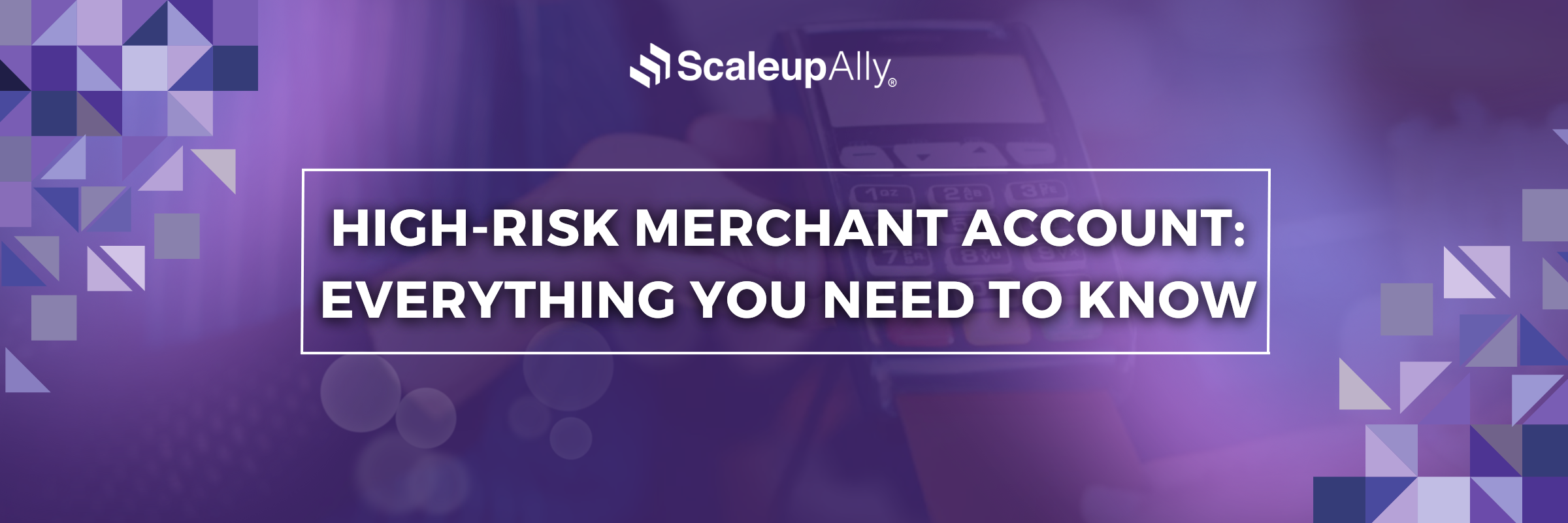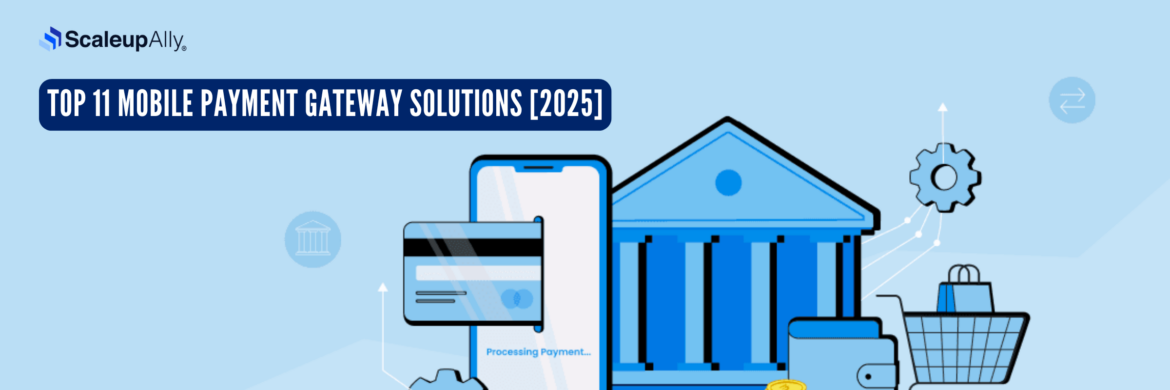
High-Risk Merchant Account: Everything You Need to Know
Suprabhat Sen | April 3, 2025 , 16 min read
Table Of Content
Rejection hurts, especially when it’s your business at stake. Thousands of legitimate business owners find themselves blacklisted by traditional payment processors every year. Not because they’re criminals. Not because they’re fraudsters. But because they’ve been branded with four words that change everything: “high risk merchant account.”
The payment processing world operates on a binary system that feels almost medieval. You’re either “safe” or “dangerous.” If you run a perfectly legal business in industries like CBD, online gaming, or adult entertainment, then you’ve been flagged as high risk.
This financial segregation exists in plain sight yet remains strangely under-discussed. The consequences shape which businesses survive, which innovations reach the market, and ultimately, what products and services we as consumers can access.
In this blog post, we explore in detail what a high risk merchant account is, what its benefits and drawbacks are, and the top industries that use such accounts. You will also learn how to choose the best high risk payment gateway provider for your business.
Key Takeaways
- High-risk merchant accounts are for businesses that regular banks avoid (like CBD, gaming, or travel) due to chargebacks, fraud or regulatory concerns.
- Expect fees of 3.5%-10%, cash reserves (5%-20%), and tougher contracts on high risk merchant accounts because they come with higher costs and stricter rules.
- Not all providers are equal. Choose one with experience in your industry, with transparent pricing, and strong fraud protection.
- Control chargebacks (<1-2%), use fraud tools, and keep clear records to avoid account issues. Prevention is the best way.
- Manage smartly by monitoring fees, communicating clearly with customers, and staying compliant to keep processing smooth.
What Is a High-Risk Merchant Account?
- What Is a High-Risk Merchant Account?
- What are some of the Characteristics of High Risk Businesses?
- How are High Risk Accounts Different from Regular Accounts?
- Common Industries That Require a High-Risk Merchant Account
- Benefits and Drawbacks of High-Risk Accounts
- How can Businesses qualify for a High-Risk Merchant Account?
- How to Choose the Ideal High-Risk Merchant Account Service Provider?
- Tips for Managing a High-Risk Merchant Account Effectively
- Conclusion
- Frequently Asked Questions
A high-risk merchant account is a specialized payment processing account for businesses that traditional banks and payment processors consider too risky to handle under standard terms.
But “high risk” rarely means what you think it does.
Your business might be labeled high-risk because you sell perfectly legal CBD products. Or because you operate in the travel industry, where customers book months in advance. Maybe you run an online subscription service with recurring billing. Or perhaps your business is new and lacks processing history.
Once branded “high risk,” you’ll face higher processing fees, longer fund-holding periods, and mandatory cash reserves. These additional financial burdens can increase your business’s vulnerability.
What are some of the Characteristics of High Risk Businesses?
The label “high risk merchants” sticks to businesses often for reasons beyond their control. But what exactly triggers this designation? Here are some reasons:
1. Their Service Industry matters
Certain sectors get automatically flagged regardless of how well you run your operation. Adult entertainment, online gambling, cryptocurrency exchanges, travel agencies, subscription services, and firearms dealers all wear the high risk tag. CBD merchants might run completely legitimate operations yet still find themselves looking for payment processing.
2. Irregular cash flow patterns
This characteristic in particular raises immediate red flags. If your business experiences seasonal spikes or unpredictable revenue streams (festival organizers or weather-dependent services, for example), banks see volatility, and volatility means “risky”.
3. International operations
This characteristic will also multiply your risk profile exponentially. Cross-border transactions introduce variables like currency fluctuations, different regulatory frameworks, and increased fraud potential. A purely domestic business selling the exact same products might qualify for standard processing while its international counterpart gets shunted to high-risk territory.
4. Chargeback history
Your chargeback history can haunt you for years. Industries where customers commonly experience “buyer’s remorse” (fitness programs, dating sites) or where delivery timelines are extended (custom furniture, construction) naturally generate more disputes. Even a 1% chargeback ratio can push you into the high risk category.
5. Credit requirements
Without established business credit or with personal scores below 580, many high risk merchants find themselves battling both their industry classification and credit limitations simultaneously.
6. Regulatory uncertainty
Businesses operating in legally evolving spaces (marijuana dispensaries in states with changing laws, for example) face heightened scrutiny regardless of their compliance efforts.
We would like to add that many high risk merchants run exceptionally tight operations precisely because they know they’re under the microscope. Their fraud prevention measures often exceed those of “standard risk” businesses, yet they still pay the high risk premium.
The system doesn’t measure actual risk. It measures perceived risk based on outdated categorizations and oversimplified metrics.
How are High Risk Accounts Different from Regular Accounts?
When you partner with a high-risk payment processor, you’re entering a completely different financial ecosystem with its own rules, limitations, and costs. Here’s how to differentiate between a regular account and a high risk account:
| Parameter | High Risk Account | Regular Account |
| Payment Processing Fees | 3.5% – 15% + $0.25-$0.50 per transaction | Typically 1.5% – 2.9% + $0.10-$0.30 per transactio |
| Application Process | 1-2 weeks with extensive business history review, financial statements, and processing history | Usually 1-3 days with minimal documentation |
| Chargeback Fees | $25-$100 per chargeback, plus potential for additional penalties | $15-$25 per chargeback |
| Cash Reserve Requirements | Common requirement holding 5%-20% of processing volume for 6 months or longer | Rarely required |
| Volume Caps | Strict monthly processing limits with penalties for exceeding them | Generous limits with room for growth |
These differences fundamentally alter business economics. A high-risk classification can reduce profit margins by 3-10% compared to identical businesses with standard accounts, creating an uphill battle for sustainability and growth.
Common Industries That Require a High-Risk Merchant Account
High-risk payment gateways aren’t just for businesses operating in gray areas. Many thriving, legitimate industries find themselves automatically flagged simply due to their business model or customer patterns.
Here’s a breakdown of the most common sectors that typically require specialized high-risk merchant accounts:
1. Adult Entertainment
The adult entertainment industry faces high-risk designation despite its massive market size. Payment processors worry about high chargeback rates (often from embarrassed customers), potential legal issues across jurisdictions, and reputation risks.
These businesses typically pay processing fees 2-4 times higher than standard merchants while maneuvering complex content regulations and frequent account reviews.
2. Online Gaming and Gambling
Gambling businesses (from fantasy sports to poker platforms) face intense regulatory scrutiny across different regions. The combination of varying legal frameworks, addiction concerns, and frequent disputes over outcomes makes these businesses high-risk by default.
Many operate with multiple backup payment processors to ensure business continuity when primary accounts face unexpected holds or terminations.
3. CBD and Cannabis Products
The legal landscape around CBD creates a processing nightmare. Despite federal legality of hemp-derived CBD, most major banks refuse standard processing due to confusion with marijuana products and inconsistent state regulations.
CBD merchants often find their accounts suddenly terminated without warning, forcing them to constantly seek new payment processing relationships.
4. Travel and Accommodations
The extended timeframe between booking and service delivery creates heightened risk exposure. When customers book trips months in advance, the potential for business failure, service changes, or customer disputes increases dramatically.
Travel businesses typically face higher reserve requirements, with processors sometimes holding 15-20% of their funds for 180+ days as security against future chargebacks.
5. Subscription Services
Recurring billing models trigger automatic high-risk classification due to their continuous billing nature. Free-trial-to-paid models particularly concern processors due to potential “forgotten subscription” chargebacks.
These businesses face stricter customer verification requirements and often must implement enhanced cancellation procedures to maintain their accounts in good standing.
6. Firearms and Ammunition
Political sensitivity combined with strict regulations makes firearms dealers high-risk regardless of their compliance record. These businesses face frequent payment processor relationship changes as banks adjust their risk policies.
Many gun shops operate with multiple backup processing solutions and maintain higher cash reserves to weather processing disruptions.
7. Debt Collection
The contentious nature of debt collection triggers an automatic high-risk designation. High dispute rates, regulatory scrutiny, and the potential for consumer protection issues create processing challenges.
Collection agencies typically pay 4-8% in processing fees compared to standard rates of 2-3%, significantly impacting their operational margins.
Benefits and Drawbacks of High-Risk Accounts
High-risk online payment processing comes with significant trade-offs. While the costs and restrictions can seem overwhelming, there are surprising advantages that help explain why many businesses successfully operate under this classification. Let’s examine both sides:
Benefits
1. Higher Revenue Potential
Industries classified as high-risk often enjoy less competition and higher profit margins. CBD companies, for example, typically see 25-40% profit margins compared to 10-15% in standard retail.
The additional processing costs are often offset by premium pricing power in specialized markets where customers expect to pay more for niche products and services.
2. Global Market Access
High-risk processors typically offer more flexible international payment solutions than standard accounts. This allows businesses to capture revenue from regions that conservative payment processors avoid.
For subscription-based companies, this global reach can increase their potential customer base by 300-400% compared to domestic-only operations.
3. Greater Processing Stability
Once established with a high-risk processor, businesses often experience fewer arbitrary account shutdowns. These processors understand industry-specific challenges and don’t panic at transaction patterns that would trigger automatic freezes with conventional banks.
This operational stability helps businesses focus on growth rather than constantly searching for new payment relationships.
4. Enhanced Fraud Protection
High-risk payment processors typically offer more sophisticated fraud detection tools as standard features. These advanced security measures help businesses identify suspicious transactions before they become costly chargebacks, often reducing fraud losses by 30-50% compared to basic processing solutions.
Drawbacks
1. Significantly Higher Fees
The most painful drawback is cost. High-risk merchants typically pay 4-10% per transaction versus 2-3% for standard accounts. For a business processing $500,000 annually, this difference can amount to $35,000+ in additional expenses, directly impacting bottom-line profitability and cash flow.
2. Mandatory Cash Reserves
Most high-risk processors require rolling reserves that hold back 5-15% of your revenue for 6-12 months. This creates serious cash flow challenges, essentially forcing businesses to operate with only 85-95% of their actual revenue available. For growing businesses, this capital restriction can severely limit expansion opportunities.
3. Stringent Contract Terms
High-risk merchant agreements typically lock businesses into 2-3 year contracts with hefty early termination fees (often $500-$1,000 plus liquidated damages). These restrictive terms make it difficult to negotiate better rates or switch providers as your business establishes a positive processing history.
4. Volume Limitations
Processing caps restrict how much revenue you can process monthly, with significant penalties for exceeding these limits. A business experiencing unexpected growth might suddenly find itself unable to accept additional payments or facing substantial penalty fees that erase the profit from those extra sales.
How can Businesses qualify for a High-Risk Merchant Account?
Securing high risk merchant payment processing isn’t automatic, even for businesses that clearly need it. The application process involves more scrutiny and preparation than standard merchant accounts. While approval isn’t guaranteed, the below steps can increase your chances of qualifying:
1. Prepare Comprehensive Documentation
Most high-risk processors require extensive paperwork that standard merchants never encounter. Gather at least 3-6 months of processing statements (if available), bank statements, articles of incorporation, business licenses, and personal identification.
Processors want to see transaction volumes, chargeback ratios, and business legitimacy before taking you on. The more organized and complete your documentation, the faster your approval process typically moves.
2. Improve Your Credit Profile
While less-than-perfect credit won’t automatically disqualify you, stronger scores improve your terms. Business owners with scores above 650 typically receive more favorable rates and lower reserve requirements.
If your personal credit is challenging, consider adding a business partner with stronger credit as a co-signer or focusing on business credit building for 3-6 months before applying.
3. Implement Fraud Prevention
Demonstrate that you’re actively reducing risk factors within your control. Document your chargeback prevention strategy, customer verification procedures, and refund policies.
Businesses that can show clear protocols for address verification, CVV validation, and suspicious transaction monitoring typically receive more favorable consideration during the underwriting process.
4. Create a Professional Online Presence
Underwriters will scrutinize your website and online footprint extensively. Ensure your site has clear terms of service, privacy policies, shipping information, and customer service contacts. Remove any misleading claims or marketing language that could trigger regulatory concerns.
Many applications are rejected simply because websites appear unprofessional or contain compliance red flags.
5. Be Transparent About Your Business Model
Hiding aspects of your business model is the fastest path to rejection. If you operate in multiple industries or have a complex revenue structure, explain this clearly in your application. Processors appreciate candor and are more likely to approve businesses that demonstrate full transparency, even when operating in challenging industries.
6. Consider Working With a Payment Broker
Specialized payment brokers have established relationships with multiple high-risk processors and understand which ones are currently accepting specific business types. They can often secure approval when direct applications fail, and many can negotiate lower rates than you’d receive applying independently.
The best brokers don’t charge upfront fees, instead, they earn commissions from processors on approved accounts.
7. Start With Realistic Expectations
Many new high-risk merchants face stricter initial terms that can ease over time. Be prepared for higher initial reserves and processing caps with the understanding that these can be renegotiated after 6-12 months of clean processing history.
Processors reward stability. Businesses that maintain low chargeback ratios and consistent volumes typically receive improved terms after their initial probationary period.
How to Choose the Ideal High-Risk Merchant Account Service Provider?
Here are key factors to consider when selecting your ideal high-risk merchant services partner:
1. Industry-Specific Experience
Not all payment processors for high-risk merchants understand every sector equally. Look for providers with:
- Proven track record in your industry (CBD, gaming, travel, etc.)
- Knowledge of compliance requirements for your business model
- Case studies or client references from similar businesses
2. Transparent Fee Structure
High-risk processing costs more, but hidden fees can cripple margins. Demand clear breakdowns of:
- Processing rates (per transaction and monthly)
- Chargeback fees
- Reserve requirements (percentage and duration)
- Early termination penalties
3. Risk Management Capabilities
Your payment processor should offer high-risk solutions like:
- Real-time fraud monitoring
- Chargeback prevention tools
- Dispute resolution support
- Secure payment gateways with tokenization
4. Payout Terms & Cash Flow Considerations
Evaluate:
- Settlement timelines (daily vs. weekly payouts)
- Reserve withholding policies
- Options for faster funding (for additional fees)
5. Contract Flexibility
Avoid being locked into unfavorable terms:
- Prefer month-to-month over multi-year contracts
- Negotiate volume thresholds before signing
- Understand termination conditions
6. Customer Support & Reliability
Ensure your provider offers:
- 24/7 technical support
- Dedicated account management
- Quick response times for payment issues
Always request a merchant account agreement review from your legal counsel before committing to any payment processor for high-risk operations.
Tips for Managing a High-Risk Merchant Account Effectively
Successfully operating with high risk merchant account services requires management to maintain healthy cash flow. Implement these best practices to optimize your account performance:
1. Monitor Chargebacks Religiously
- Keep your dispute ratio below 1-2% of transactions
- Use chargeback alerts and prevention tools from your high-risk merchant account services
- Respond to all retrieval requests within deadlines
- Maintain detailed records of customer transactions and communications
2. Strengthen Fraud Prevention
- Implement multi-layered fraud screening (AVS, CVV, 3D Secure)
- Review transactions for red flags like:
- Large first-time orders
- Rush shipping requests
- Multiple cards from a single IP
- Consider AI-powered fraud tools for better detection
3. Maintain Financial Transparency
- Keep clean financial records and processing statements
- Notify your provider about expected sales spikes
- Build cash reserves to cover potential holds or delays
4. Optimize Customer Communication
- Make billing descriptors recognizable
- Provide clear contact information on statements
- Send order confirmations and shipping notifications
- Offer easy self-service cancellation options
5. Regularly Review Account Terms
- Audit monthly statements for fee changes
- Track reserve account balances
- Renegotiate rates as your business matures
- Stay current on compliance requirements
Consider working with a specialized high-risk merchant account services consultant annually to review your payment strategy and identify optimization opportunities.
Conclusion
High-risk merchant accounts exist for one reason: because some of the most innovative, profitable business models don’t fit neatly into traditional banking boxes.
Businesses in high-risk sectors process billions annually because they meet market demands. Your payment strategy shouldn’t hold you back from serving that demand. With the right provider, transparent terms, and smart management, your merchant account becomes an invisible, reliable foundation for your operations and not an obstacle to them.
The companies that win in high-risk industries aren’t those that dwell on the label, but those who master their financial infrastructure. Now that you understand the landscape, you’re equipped to make payment processing a seamless part of your success story.
Frequently Asked Questions
Q: How do I know if my business is high-risk?
Your business may be classified as high-risk if you operate in industries like gaming/gambling, travel or CBD, have high chargeback rates, or process international transactions. Payment processors evaluate factors like industry type, credit history, and processing volume to determine if a business falls under the high risk category or not.
Q: How much does a high-risk merchant account cost?
Costs typically range from 3.5%–10% per transaction, plus additional fees like setup charges, monthly maintenance, and rolling reserves (5%–20% of revenue held as collateral).
Q. How can I reduce chargebacks with a high-risk account?
Use fraud filters (AVS, CVV verification), provide clear billing descriptors, offer responsive customer service, and maintain detailed transaction records. Keeping chargebacks below 1%–2% helps avoid penalties.
Q: What documents are needed to apply for a high-risk merchant account?
Expect to submit 6+ months of bank statements, processing history (if applicable), business licenses, tax IDs and sometimes personal credit reports. Please note that requirements might vary by provider and industry.
Related Blogs

15 Best Payment Gateways in the UAE in 2025 [Latest Updated]
Discover the top 15 payment gateway options in the UAE, including features, and pricing plans for businesses seeking secure online transactions.
Suprabhat Sen
Nov 25 ,
13 min read

Top 13 Mobile Payment Gateway Solutions [2025]
Discover the top 13 mobile payment gateways, with key features, pros, cons, and integration tips to help you choose the best solution for your app.
Suprabhat Sen
Nov 8 ,
18 min read

10 Best Ecommerce Payment Gateways in UAE
Explore the best ecommerce payment gateways in UAE. Compare providers, costs, compliance, and features to choose the right solution for your business.
Suprabhat Sen
Sep 30 ,
13 min read


